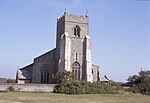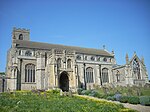The Shell Museum
Museums in NorfolkNatural history museums in EnglandShell museumsUnited Kingdom museum stubsUse British English from February 2023

The Shell Museum in Glandford, Norfolk is the oldest museum in the county and holds one of the country's largest collections of sea shells. It was founded by Alfred Jodrell. As well as sea shells it contains articles made out of shells, fossils, bird eggs and local archaeological finds. It also has a collection of work by John Craske.Prior to the construction of the museum the collection was housed in boxes in the founder's house.
Excerpt from the Wikipedia article The Shell Museum (License: CC BY-SA 3.0, Authors, Images).The Shell Museum
Hurdle Lane, North Norfolk Letheringsett with Glandford
Geographical coordinates (GPS) Address Website External links Nearby Places Show on map
Geographical coordinates (GPS)
| Latitude | Longitude |
|---|---|
| N 52.931555555556 ° | E 1.0397777777778 ° |
Address
The Shell Museum
Hurdle Lane
NR25 7JR North Norfolk, Letheringsett with Glandford
England, United Kingdom
Open on Google Maps










